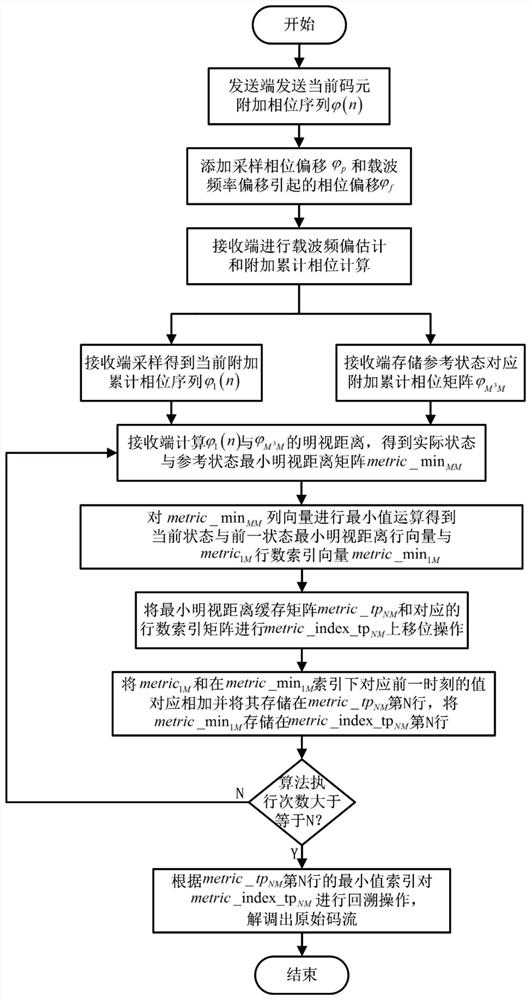Demodulation method of n-order Viterbi idea applied in m-gfsk phase domain
A technology of M-GFSK and demodulation method, which is applied in M-GFSK modulation and demodulation system. The N-order Viterbi thought is applied in the field of M-GFSK phase domain demodulation, which can solve the problem of system demodulation performance degradation and accurate calculation of βi Reduce the degree of degradation and other issues, to achieve the effect of reducing computational complexity, improving the performance of the demodulation error rate, and increasing flexibility
- Summary
- Abstract
- Description
- Claims
- Application Information
AI Technical Summary
Problems solved by technology
Method used
Image
Examples
Embodiment 1
[0063] Embodiment 1: 3rd order Viterbi is applied in 2-GFSK system, then N=3, M=2. Proceed as follows:
[0064] Step 1, the receiver receives the After carrier frequency offset estimation and phase compensation right Perform data sampling to obtain additional cumulative phase sequence in is the additional cumulative phase generated from the original binary data, and ω(n) is Gaussian white noise.
[0065] will result in an additional accumulated phase value at the receiver Deviation from the correct value will cause the bit error rate performance of the received data to decrease. In order to improve the bit error rate performance of the received data, it is necessary to first Correction is performed, and before correction, it is necessary to accurately estimate
[0066] Step 2, store the reference state at the receiving end corresponding to the additional cumulative phase matrix
[0067] Assume is the additional phase generated for the original symbol, th...
Embodiment 2
[0085] Embodiment 2: 3rd order Viterbi is applied in 2-GFSK system, then N=3, M=2. Proceed as follows:
[0086] Steps 1 and 2 are the same as in Example 1.
[0087] Step 3, yes Perform a first-level state merge to get related to the current state, the previous two states, according to calculate and The Mingshi distance of the actual state and the reference state Mingshi distance matrix metric_dis 42 .
[0088] Step 4, for metric_dis 42 Perform the Viterbi method to obtain the minimum Mingshi distance cache matrix metric_tp 32 And the index matrix metric_index_tp corresponding to the minimum Mingshi distance row number 32 .
[0089] The specific implementation of this step is as follows:
[0090] 4a) For metric_dis 42 The minimum value operation is performed for every 2 row vectors to obtain the minimum Mingshi distance matrix metric_min between the actual state and the reference state 22 :
[0091] 4b) For metric_min 22 Perform the minimum value operation o...
Embodiment 3
[0093] Embodiment 3: 3rd order Viterbi is applied in 2-GFSK system, then N=3, M=2. Proceed as follows:
[0094] Steps 1 and 2 are the same as in Example 1.
[0095] Step 3, yes Perform secondary state merging to get related to the current state, the previous state, according to calculate and Mingz distance, get the minimum Mingz distance matrix metric_min between the actual state and the reference state 22 .
[0096] Step 4, for metric_min 22 Perform the Viterbi method to obtain the minimum Mingshi distance cache matrix metric_tp 32 And the index matrix metric_index_tp corresponding to the minimum Mingshi distance row number 32 . for metric_min 22 Perform the minimum value operation on the column vector to obtain the minimum Ming's distance row vector metric between the current state and the previous state 12 and metric_min 22 The index row vector metric_index corresponding to the minimum Mingshi distance row number 12 .
[0097] Steps 5 to 11 are the same ...
PUM
 Login to View More
Login to View More Abstract
Description
Claims
Application Information
 Login to View More
Login to View More - R&D
- Intellectual Property
- Life Sciences
- Materials
- Tech Scout
- Unparalleled Data Quality
- Higher Quality Content
- 60% Fewer Hallucinations
Browse by: Latest US Patents, China's latest patents, Technical Efficacy Thesaurus, Application Domain, Technology Topic, Popular Technical Reports.
© 2025 PatSnap. All rights reserved.Legal|Privacy policy|Modern Slavery Act Transparency Statement|Sitemap|About US| Contact US: help@patsnap.com



